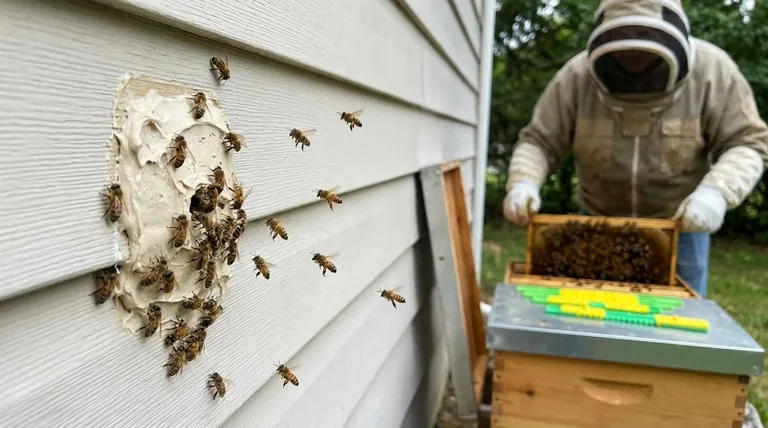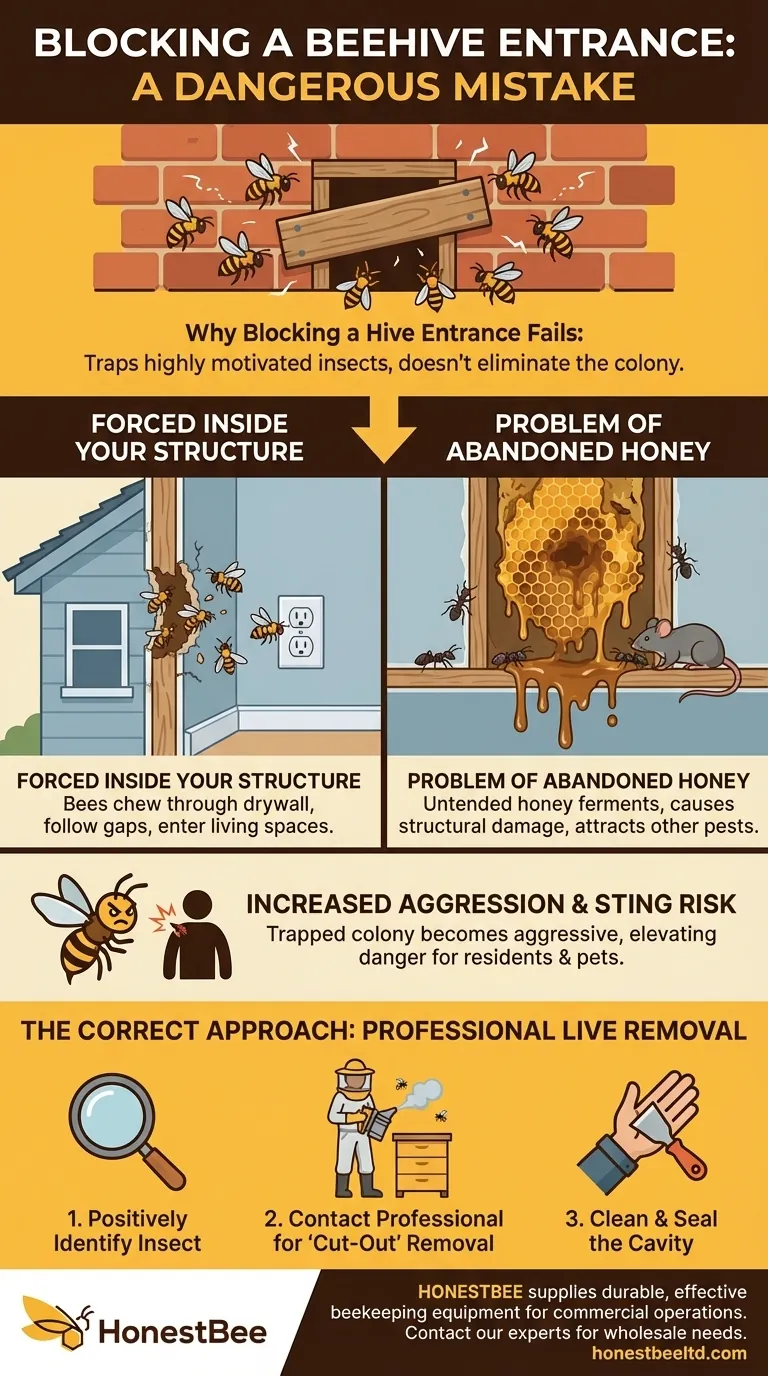Blocking the entrance to a beehive is a common but dangerous mistake. This action does not eliminate the colony but instead traps thousands of highly motivated insects. Rather than dying or leaving, the bees will immediately work to find or create an alternative exit, which often forces them deeper into the structure they inhabit.
Attempting to solve a bee problem by blocking the hive entrance is a fundamentally flawed strategy. It fails to address the core issue—the colony itself—and frequently transforms a manageable external problem into a hazardous internal infestation.

Why Blocking a Hive Entrance Fails
A honey bee colony is a complex, resilient organism. Simply obstructing its primary access point triggers a predictable and problematic series of behaviors driven by the colony's instinct to survive.
The Inevitable Search for a New Exit
A hive entrance is a two-way street. Foraging bees are constantly returning with pollen and nectar, and guard bees are defending the colony.
When their main path is blocked, the bees inside are cut off from resources, and the thousands of foragers outside are desperate to return to their brood and queen. This creates immense pressure, forcing them to seek any other available crack or crevice.
Forcing Bees Inside Your Structure
If the bee colony is located within the wall or roof cavity of a building, blocking the external entrance is especially hazardous.
The bees' frantic search for a new exit will likely lead them inward. They can chew through drywall or follow gaps around plumbing, electrical outlets, and light fixtures, emerging agitated and disoriented inside your living space.
The Problem of Abandoned Honey
In the unlikely event that blocking the entrance does kill the colony, the problem is not over. A mature hive can contain many pounds of honey and wax comb.
Without the bees to regulate temperature and humidity, this untended honey will ferment and rot. It will seep through walls and ceilings, causing stains and structural damage while attracting other pests like ants, cockroaches, and rodents.
Understanding the Risks and Unintended Consequences
The strategy of blocking a hive entrance is not just ineffective; it actively creates new and more serious risks for both property and people.
Increased Aggression and Sting Risk
A trapped, confused, and threatened bee colony is an aggressive one. By blocking their entrance, you create a state of high alert.
The bees are more likely to sting anyone or anything near the original hive location or their new, unpredictable exit points. This elevates the danger for residents, visitors, and pets.
Failure to Remove the Core Problem
The entrance is merely a symptom of the real issue: the established colony, including the queen, brood, and honeycomb.
As long as the queen and comb remain, the fundamental problem persists. Even if some bees are killed, the remaining colony can rebuild, or the abandoned hive will decay and cause secondary damage.
The Correct Approach: Addressing the Colony Directly
A successful and safe resolution requires focusing on the entire colony, not just its doorway. This is a task best left to professionals who understand bee behavior.
Step 1: Positively Identify the Insect
First, confirm you are dealing with honey bees. Yellow jackets, wasps, and hornets are often mistaken for bees but require different removal strategies. Honey bees are vital pollinators, and live removal is always the preferred option.
Step 2: Contact a Professional for Removal
Do not attempt a DIY removal or extermination. Instead, contact a local beekeeper or a specialized pest management company that performs live bee removals.
Beekeepers have the tools and expertise to safely extract the bees and the entire honeycomb. This process, often called a "cut-out," is the only way to ensure the problem is solved permanently.
Step 3: Clean and Seal the Cavity
After the colony is removed, the cavity must be thoroughly scraped and cleaned to remove all wax and honey. This eliminates the scents that could attract a new swarm in the future. Finally, all potential entry points in the area must be securely sealed.
Making the Right Choice for Your Goal
- If your primary focus is a quick, DIY solution: Understand that blocking the hive entrance is ineffective and hazardous, often creating a more significant and dangerous problem inside your home.
- If your primary focus is safely and permanently removing the bees: Contact a local beekeeper or a pest control service that specializes in live bee removal and structural cut-outs.
- If your primary focus is preventing future infestations: Ensure the professional who removes the colony also cleans the cavity and securely seals all entry points to eliminate lingering odors.
Solving a bee problem requires addressing the colony, not just its doorway.
Summary Table:
| Consequence of Blocking Hive Entrance | Result |
|---|---|
| Bees Search for New Exit | Forces them deeper into walls/structures |
| Increased Aggression | Higher risk of stings for residents and pets |
| Abandoned Honey & Comb | Attracts other pests; causes structural damage |
| Colony Not Eliminated | Problem persists and often worsens |
Don't let a bee problem become a hazardous infestation. For commercial apiaries and distributors, proper hive management starts with the right equipment. HONESTBEE supplies durable, effective beekeeping supplies and equipment through wholesale-focused operations, helping you maintain healthy, manageable colonies. Contact our experts today to discuss your wholesale needs and ensure you have the tools for success.
Visual Guide

Related Products
- Multi-Functional Sliding Hive Entrance for Beekeeping
- Beehive Entrance Reducer Guardian Metal Hive Entrance for Bees
- Professional Reversible Beehive Hive Entrance
- Multi-Functional Rotary Hive Entrance Disc for Beekeeping
- Beehive Entrance Discs Plastic Bee Entrance Disc for Bee Hives
People Also Ask
- How can a Langstroth hive entrance be adjusted? Mimic Natural Bee Preferences for a Healthier Hive
- How do bees manage debris with a small hive entrance? A Guide to Strategic Hive Management
- How does entrance configuration vary seasonally for beekeepers? A Guide to Year-Round Hive Health
- What are some alternative strategies to using entrance reducers? Empower Your Bees for Natural Hive Defense
- What are the different entrance sizes for an 8 or 10-frame Langstroth hive? A Guide to Seasonal Management



















